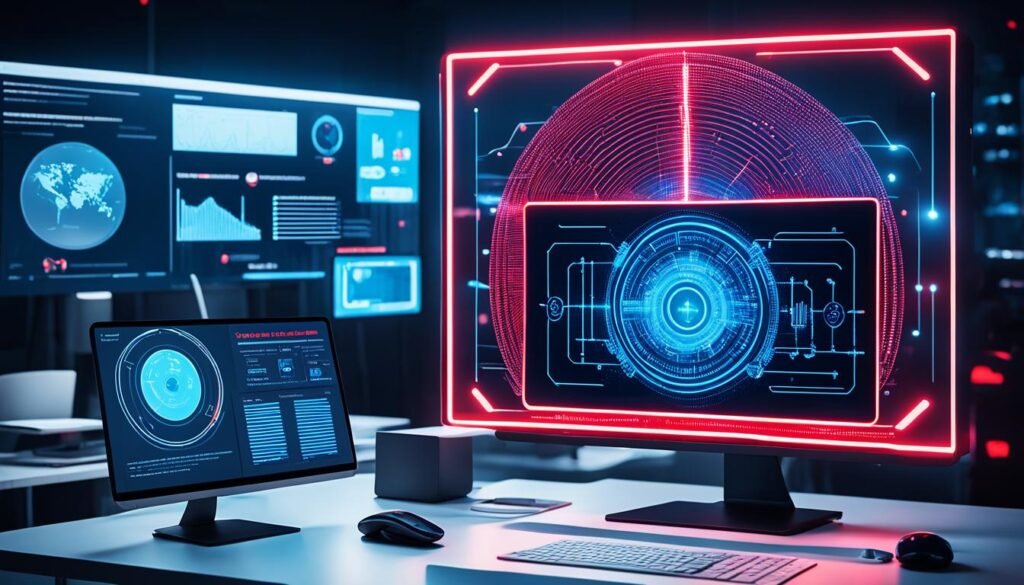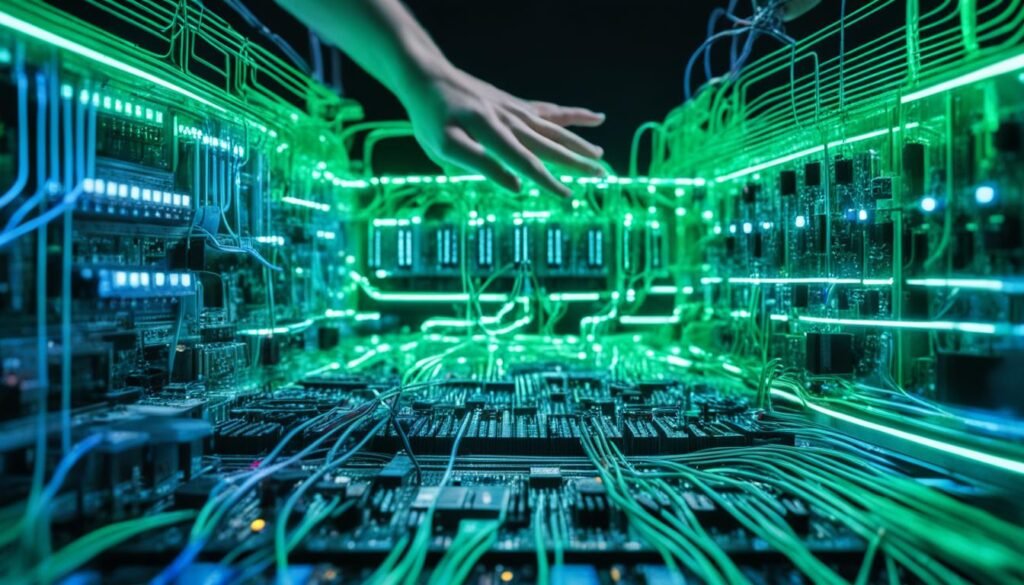In today’s digital world, it’s crucial to tell human-made from AI-made text. AI content detectors lead the way in this area. They help spot AI-created content for things like checking school work or reviewing online reviews. It’s key to know how these tools work and what they do for us.
Understanding concepts like how AI detectors work and machine learning is vital. We also need to know about computer vision, deep learning, and more. These topics help us see the importance of AI detectors in our lives.
Key Takeaways
- AI content detectors use machine learning and deep learning to spot patterns in text that show it was made by AI.
- They look at things like perplexity and burstiness to tell human-written from AI-generated text.
- Even the best detectors can be fooled, showing we need to keep improving them.
- These detectors are useful in many areas, like education and finance, but we must remember their limits.
- To make text seem more real, writers can use varied vocabulary and avoid repetitive phrases. Adjusting the tone also helps.
Introduction to AI Content Detectors
AI is getting better at telling AI-written content from human text. AI content detectors use machine learning and deep learning to spot AI-made text. These tools are changing how we check if online content is real or not. They help in many areas, like education, shopping online, and news.
The Working of AI Content Detectors
Machine learning is key to AI content detectors. It trains algorithms to make predictions and decisions on their own. Deep learning is even more advanced, using complex networks to analyze lots of data and learn from it. Both are vital for spotting AI-generated content, helping us tell human-written from machine-made text.
Automated Content Detection
Automated content detection uses algorithms to find certain patterns in text. It looks for things like writing style and grammar. The aim is to spot content that seems too perfect or different, which might mean it’s AI-made. These tools are important in many fields, keeping content real and trustworthy in education, online shops, news, and social media.

“The accuracy rates of AI content detection tools can vary significantly. For instance, research conducted by members of the European Network for Academic Integrity revealed that the accuracy of the best AI content detectors tested ranged from 50% to 66%.”
Fundamentals of AI Detection Methods
Understanding how AI content detectors work is key to spotting AI-generated text. They look at things like writing style and use complex algorithms. These tools aim to find the small differences that show if text was written by a human or a machine.
Stylometric Features: Vocabulary and Beyond
AI detectors check text for certain traits that help tell human from machine-made content. They look at how diverse the words are, sentence length, and how the text is read easily. These traits help spot AI-generated text.
Classifiers: The Decision-Makers
At the heart of an AI detector is the classifier. It’s trained to find the differences between human and AI-written text by looking at the traits mentioned before. By learning from many examples, it gets better at spotting AI-generated content.
Algorithms: The Underlying Mechanics
AI detectors use complex algorithms to understand the data and find AI-generated content. N-grams look at word sequences to understand context and predict word combinations. Syntax analysis checks how words are arranged in sentences. Lexical analysis breaks text into smaller parts to see if it sounds human or machine-made.

By using stylometric features, classifiers, and advanced algorithms, AI detectors aim to tell if digital content is real or not. This helps users make smart choices and keep information trustworthy in our digital world.
The Process of AI Content Detection
Exploring AI content detection reveals a complex process. It uses advanced tech to spot machine-generated text. At its core, AI detectors carefully check each word and sentence. They look for signs that show if the content is made by humans or AI.
Step-by-Step Explanation
The process starts with the AI checking the text closely. It uses machine learning models to find patterns in AI-generated content. These patterns include perplexity and burstiness, which are about predictability and sentence structure. After analyzing, the AI gives a score that shows how likely the text is AI-generated.
Machine Learning’s Role
Machine learning models are key to AI content detectors. They learn from lots of text from both humans and AI. This training makes them better at telling human and AI texts apart. The more examples they see, the more accurate they become at spotting AI-generated texts.
Challenges and Limitations
AI content detectors are powerful but face big challenges. Complex texts can be hard to tell apart from human writing. As AI writing tools get better, they start to mimic human writing more closely. This makes detection harder.
Handling a lot of content and the need for powerful computers also add to the challenges. These issues make us wonder how reliable these detectors are.

In the world of AI-generated content, detecting AI is a constant challenge. It’s a balance between machine learning progress and human creativity. As AI detectors get better, we keep asking: Can we really trust these tools? And how can we use them right to keep the written word honest?
Evaluating the Accuracy of AI Detectors
AI writing tools are getting better, so it’s key to check how accurate AI content detectors are. The quality and variety of the data used to train the AI models matter a lot. A big dataset helps the model learn about different writing styles. This makes it better at spotting AI-generated content.
Also, the algorithms behind these detectors need to update as AI writing tools improve. As AI gets better at sounding like humans, the detectors must also get better to stay accurate. How fast and well the detectors work also affects how reliable they are.
Factors Affecting AI Detector Accuracy
- Training Data Quality and Diversity: The AI models need a wide range of human writing examples to tell AI-generated content apart.
- Algorithmic Adaptability: The algorithms must update with AI writing tools to keep spotting AI-generated content correctly.
- Computational Efficiency: How well and fast the detection systems work affects their ability to check content and give accurate results.
| Metric | Performance |
|---|---|
| OpenAI’s AI Text Classifier | Correctly spots 26% of AI-written text as “likely AI-generated” but wrongly flags 9% of human-written text. |
| Copyleaks AI Content Detector | Has a 99% accuracy in finding AI-generated content. |
| Turnitin’s AI Detection Tool | Says it’s 98% accurate in spotting AI-created content. |
As AI writing tools get more popular, having accurate AI content detectors is more important than ever. Knowing what affects their performance helps us make better detection systems. This keeps academic work honest and fights the limits of AI detectors.
How AI Detectors Work
Exploring the world of digital intelligence, we see how AI detectors work. They use computer vision techniques and AI detection algorithms to spot AI-generated content with great accuracy.
AI detectors look at many stylometric features to understand writing styles. They check vocabulary, sentence structure, and readability. This helps them tell machine-written text from human-written content.
Thanks to machine learning, these detectors learn from huge amounts of text. They learn to spot the small differences between human and AI-generated text. This lets them check if content is real or not.
Underneath, the algorithms use n-gram analysis and syntax parsing. These methods look at the language and context of the text. They help the detectors find the signs of machine-written content.
As the internet changes, AI detectors become more important. They help keep online content true and stop the spread of fake news. By keeping up with these changes, we can trust and navigate the digital world better.
| Key Insights on How AI Detectors Work |
|---|
|

“The rise of AI-generated content has made the need for reliable detection tools more crucial than ever. AI detectors play a pivotal role in safeguarding the integrity of digital communication and promoting trust in the online world.”
Who Uses AI Detection Tools?
AI content detection tools are now key in many fields and jobs. They help educators, students, writers, marketers, researchers, journalists, recruiters, and social media moderators. These tools keep content true and original, fighting plagiarism and fake news online.
In schools, AI detectors check for plagiarism in student work. Teachers use them to spot AI-generated texts by comparing them to past work. This helps teachers teach students about right and wrong uses of AI.
For writers, marketers, and journalists, AI detectors are a must. They check if texts are written by humans or AI. This is vital for keeping their work credible and boosting their online presence.
| Profession | Use Cases for AI Detectors |
|---|---|
| Educators and Students | Identifying plagiarism, verifying originality of student work, guiding ethical AI use |
| Content Creators (Writers, Marketers, Journalists) | Ensuring content authenticity, maintaining credibility and domain authority for SEO |
| Researchers | Automating data analysis, generating reports, and contributing to scientific progress |
| Recruiters | Screening job applications for authenticity and identifying potential misuse of AI |
| Social Media Moderators | Detecting and mitigating the spread of disinformation and fake news |
Researchers use AI detectors to speed up data analysis and write reports. Recruiters check job applications to spot AI misuse.
Social media moderators also use these tools. They help fight fake news and disinformation online.
As AI-generated content grows, so does the need for good detection tools. People in many fields are using these tools to keep their work honest and valuable.
The Accuracy and Limitations of AI Content Detectors
AI content detectors have made big strides, but they’re not perfect. They can mistake human-written content for AI-generated and miss AI-generated content too. The fast growth of AI writing tools makes it hard for detectors to keep up.
A study found AI detectors correctly identified AI-generated text 60% of the time. GPTRadar was 64% sure about its AI-generated content labels. ZeroGPT was over 98% accurate, but there were some doubts. These tools were better at spotting GPT 3.5 content than GPT 4, showing they struggle with human-written content.
AI detectors work best in English but struggle in other languages due to limited training data. To improve, they need to tackle biases, learn continuously, and use human oversight. This is key to address ethical issues with AI detector mistakes.
| AI Detection Tool | Accuracy Rate |
|---|---|
| GPTRadar | 64% confidence level |
| ZeroGPT | Over 98% accuracy |
| Turnitin | Error rate increased from 1% to 4% after ChatGPT launch |
Handling a lot of content and needing lots of computing power can also limit these tools. So, AI content detectors should be used with other tools to check content’s truth, and their limits should be considered.
“The performance of AI detectors varied across languages, genres, and writing styles, excelling in English but potentially faltering in other languages due to training data limitations.”
Putting AI Detectors to the Test
Many people wonder how accurate AI content detectors are. Researchers have tested popular tools with text from AI writing assistants like ChatGPT, Gemini, Claude, and Plus. They found some detectors work better than others at spotting AI-generated content.
Tools like Crossplag and Copyleaks did well in the tests. But others had trouble telling human-written from AI-generated text, especially with advanced AI tools. This shows the challenges and limits of AI content detection. It also points out the need for more progress in this area.
Some key insights from the testing process include:
- Originality.ai claims a 99% accuracy rate in detecting AI content.
- Originality.ai identified a 96% human and 4% AI split in a 500-word article.
- Turnitin’s AI Writing Detection tool rated an essay as 98% human-generated and 2% AI-generated.
- Winston AI scored a human-generated text at 75% human and 25% likely AI, while detecting an AI-generated text as 1% human-generated.
- Copyleaks accurately determined human-generated text as human-generated and highlighted an AI-generated text in red, indicating its machine-generated status.
- Content at Scale AI detector claimed an 85% accuracy rate, rating an AI-generated text at 31% human-written and a human-generated article at a perfect 100% human-written.
These findings highlight the ongoing challenge of testing ai detectors and their accuracy. While some tools show promise, the limitations of ai detectors are still a big concern. This is especially true as AI writing technologies keep getting better.
“Detecting AI-generated content accurately is vital for maintaining information credibility and countering threats effectively.”
The Future of AI Content Detection
The world is diving deep into the world of AI writing tools, and the future looks exciting. AI content detection is getting better with new machine learning and natural language processing. These advancements mean we’ll see more accurate AI detectors that can keep up with AI-generated content.
AI writing tools are getting smarter too, learning to write like humans with amazing accuracy. This race between AI making content and detecting it will keep pushing innovation. It will lead to better detection methods.
Recent studies show AI detectors are getting really good at spotting AI-written text. One study found over 95% accuracy in identifying texts from advanced models like GPT-3 and GPT-J. This success comes from using a lot of data, training models well, and applying new techniques.
| AI Detector | Accuracy Rate | Pricing |
|---|---|---|
| Undetectable.ai | 95%+ | – |
| Originality AI | – | $0.01 per credit (100 words) |
| Copyleaks | – | – |
As AI detectors evolve, keeping digital content real and true will be key in many areas. The growth of AI detection and technology will change how we deal with AI-generated content.
“The ongoing ‘arms race’ between AI content creation and detection will shape the future of this field, driving the need for innovative approaches and continuous refinement of detection methods.”
Conclusion
The role of AI content detectors is vital in today’s digital world. They help keep information real and true. This is key as more content made by AI can look like it was written by humans.
Knowing how AI content detectors work helps you make better choices in digital content. With tools like ChatGPT getting smarter, we’ll need better ways to spot AI-made content. This ensures what we read and write is trustworthy.
The future of AI content detection will blend AI creation with better detection tech. Being able to tell human from AI-written text will be more important. This keeps the digital world honest and open. By using AI content detectors wisely, you can stay ahead in the fast-changing digital world.
FAQ
What is the role of machine learning and deep learning in AI content detectors?
Machine learning and deep learning are key in AI content detection. They help AI detect human vs. machine-made content by looking at language patterns, syntax, and structure.
What are stylometric features and how do AI content detectors use them?
Stylometric features are traits in language that help tell human from machine-made content. They include things like vocabulary, sentence length, and how often you use punctuation. AI uses these to spot AI-generated vs. human text.
How do AI content detectors work step-by-step?
AI content detection has a few steps. First, text is given as input. Then, machine learning models look for patterns in AI-generated content. Finally, a score shows how likely the text is to be AI-made.
What are the key factors that influence the accuracy of AI content detectors?
AI content detectors’ accuracy depends on several things. The quality and variety of training data matter a lot. So does the ability of the algorithms to keep up with AI writing tools’ changes. And, the power and speed of the detection systems are important too.
Who uses AI content detection tools and for what purposes?
Many professionals use AI content detection tools. They include teachers, students, writers, marketers, researchers, journalists, editors, recruiters, and social media moderators. These tools help keep content genuine and true to its source across various fields.
What are the current challenges and limitations of AI content detectors?
AI content detectors face challenges. They can make mistakes, like wrongly flagging content. The fast pace of AI writing tool advancements is another hurdle. Also, analyzing a lot of content and the need for powerful computers can limit their effectiveness.
How have AI content detectors performed in recent testing and evaluation?
Recent tests of AI content detectors show mixed results. Some tools are pretty good at telling human from machine-made text. But, others struggle, especially with advanced AI writing tools. This makes it hard to tell the two apart.
What is the future outlook for AI content detection?
The future of AI content detection looks promising and challenging. Better machine learning and natural language processing could make detectors more accurate. But, AI writing tools might get better at mimicking humans, making detection harder. This “arms race” will keep pushing the field forward, requiring new and better detection methods.
